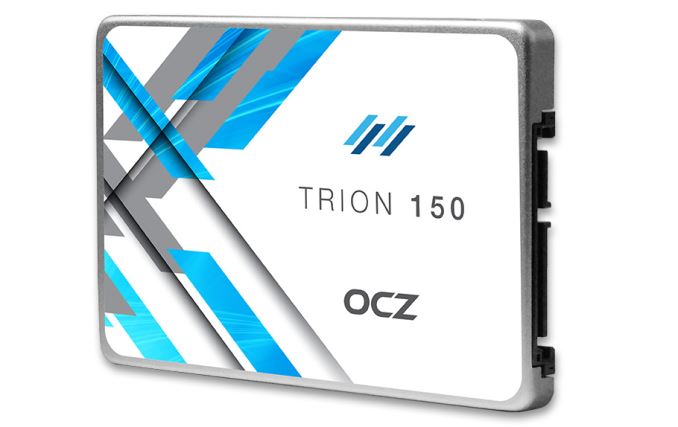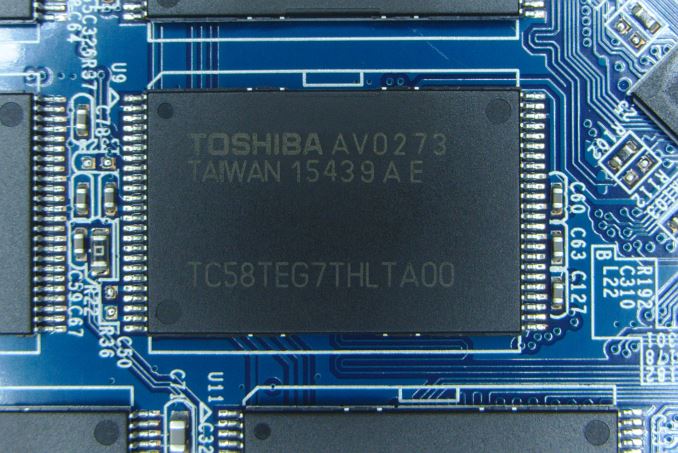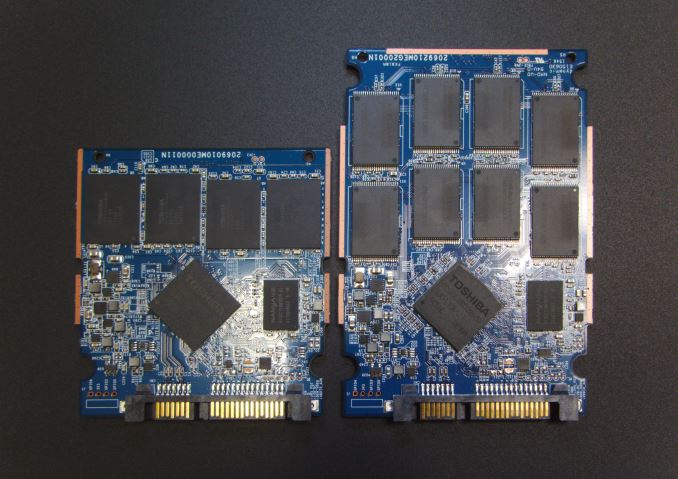The OCZ Trion 150 SSD Review
by Billy Tallis on April 1, 2016 8:00 AM EST
Last year's OCZ Trion 100 was the first drive released by OCZ as a subsidiary of Toshiba, and was really more of a Toshiba product that was released under the OCZ brand. As a prime opportunity to reestablish the OCZ brand post-bankruptcy, the Trion 100 was initially disappointing for its poor performance. It has since become clear that the Trion 100 was merely an early entrant in a race to the bottom that has seen sub-20nm planar TLC used to drive price down as much as possible even at the cost of performance.
While the price of MLC-based drives has also been declining, the new class of low-end TLC drives has made SSDs far more accessible by trading some performance for capacity. Most manufacturers are very explicit about marketing these SSDs for upgrades from hard drives rather than from earlier and smaller and more expensive SSDs, but it's hard not to make those comparisons. It's important to keep in mind that for the cheapest SSDs on the market, maximizing performance is not the only goal and often isn't even a primary goal.
Today we're taking a look at the successor to the Trion 100, the Trion 150. On paper, the OCZ Trion 150 looks like a fairly uninteresting update. The flash is changed from Toshiba's A19nm TLC to their 15nm TLC, which is cause for concern about how the smaller flash memory cells might hurt performance and endurance. The Trion is still using Toshiba's TC58NC1010 controller, a custom branded variant of Phison's S10. The performance specifications of the Trion 150 are unchanged from the Trion 100, but OCZ has made non-specific claims about performance improving for things like sustained performance. For that to be possible with what would seem to be a disadvantageous die shrink of the flash, the drive's firmware needs to be much better than the Trion 100's.
| OCZ Trion 150 Specifications | ||||||
| Capacity | 120GB | 240GB | 480GB | 960GB | ||
| Controller | Toshiba TC58NC1000 (Phison S10) | |||||
| NAND | Toshiba 15nm TLC | |||||
| Sequential Read | 550MB/s | 550MB/s | 550MB/s | 550MB/s | ||
| Sequential Write | 450MB/s | 520MB/s | 530MB/s | 530MB/s | ||
| 4KB Random Read | 79K IOPS | 90K IOPS | 90K IOPS | 90K IOPS | ||
| 4KB Random Write | 25K IOPS | 43K IOPS | 54K IOPS | 64K IOPS | ||
| Endurance | 30TB | 60TB | 120TB | 240TB | ||
| DevSleep Power | 6mW | |||||
| Idle Power | 830mW | |||||
| Max Power | 4.8W | |||||
| Warranty | Three years | |||||
| Price (Amazon) | $45.99 | $61.99 | $117.49 | $229.99 | ||
Externally the Trion 150 is very similar to the Trion 100: the casing is identical and the labeling is only slightly changed. Opening things up we immediately see that more has changed than just the NAND flash dies. The flash is now in 16 TSOP packages rather than 4 BGA packages, requiring a much larger PCB but allowing for much cheaper packaging. The layout of the PCB around the controller and DRAM is similar to the Trion 100, but there's now a thermal pad between the controller and the case.
As the successor to the Trion 100, the Trion 150 will be OCZ and Toshiba's entry-level SSD and will compete against the drives with the lowest price per gigabyte, now hovering around 20¢/GB. The primary competitors and points of comparison will be other drives with 15/16nm TLC such as ADATA's Premier SP550 and Crucial's BX200 (both using Silicon Motion's SM2256 controller) and drives from many brands using the Phison S10 platform and Toshiba TLC.
| AnandTech 2015 SSD Test System | |
| CPU | Intel Core i7-4770K running at 3.5GHz (Turbo & EIST enabled, C-states disabled) |
| Motherboard | ASUS Z97 Deluxe (BIOS 2501) |
| Chipset | Intel Z97 |
| Memory | Corsair Vengeance DDR3-1866 2x8GB (9-10-9-27 2T) |
| Graphics | Intel HD Graphics 4600 |
| Desktop Resolution | 1920 x 1200 |
| OS | Windows 8.1 x64 |
- Thanks to Intel for the Core i7-4770K CPU
- Thanks to ASUS for the Z97 Deluxe motherboard
- Thanks to Corsair for the Vengeance 16GB DDR3-1866 DRAM kit, RM750 power supply, Carbide 200R case, and Hydro H60 CPU cooler
















79 Comments
View All Comments
Arnulf - Friday, April 1, 2016 - link
So not only is this a low-end drive, it's an OCZ low-end drive.Thanks for the article and giving consumers heads-up so that we don't get burned!
Arnulf - Friday, April 1, 2016 - link
Ugh, EDIT function pretty please ...So not only is this a low-end drive, it's an overpriced OCZ low-end drive.
close - Friday, April 1, 2016 - link
I wouldn't call this a "burn" but it's definitely a warm beer after a hot summer day.LB-ID - Friday, April 1, 2016 - link
<Wanders in, sees another OCZ drive review><Reads the review, sees nothing has really changed>
<Wanders out to buy from a reputable brand>
Samus - Saturday, April 2, 2016 - link
I now feel like Toshiba is a Trojan horse, because all the OCZ drives that were in the buffer during bankruptcy and released after Toshiba initially bought them, in particular the exceptional ARC 100, were a sign they were turning things around.Then Toshiba releases this crap under the OCZ name. WTF are they thinking OCZ is a performance focused brand and these drives are clearly marketed at grandma's old Dell laptop.
xrror - Wednesday, April 6, 2016 - link
Yea but I think Toshiba's plan was to use OCZ for ALL of their customer facing drives. Before they bought OCZ they simply didn't offer retail drives at all!As far as a Toshiba Trojan horse... Toshiba actually had a competent drive itself right before it bought OCZ.
The Toshiba THNSNH drives were actually good (they don't bench awesome, but they're good) but since they were OEM only you've never heard of them. THNSNH was also a big jump from Toshiba's prior drives that seemed mostly made for industrial (performance wasn't great, but HDD wouldn't handle vibration/shock).
Bonus that Toshiba kept OCZ's in development models, so you had the ARC series come out. (vs. something ... not so nice like continuing Octane). But those were Marvell (I think) based with Indilinx firmware? Nothing wrong at all with that, but I imagine Toshiba's shareholders would question why they weren't using native Toshiba tech...
I'm actually really glad Toshiba of anyone (also, a surprise!) was able to snag the OCZ engineering team. Yea everyone loves to hate on OCZ, but OCZ really was the first company to so extremely aggressively bring SSD drives to the consumer market. Everyone likes to hate on Ryan Petersen but damnit, he really DID push to make SSD drives an affordable "thing" much MUCH sooner than just Intel alone would have.
They had a really rough time pounding out the bugs with SandForce yes... but seriously - who could have predicted that? (no, SERIOUSLY - before the kneejerk reaction, imagine being in OCZ's development shoes - that had to be really tough cause each time they thought they had it fixed, and it was always something very subtle). I always find it interesting that everyone forgets that their Indilinx controllers just worked - but they weren't the "sexy" fastest.
Saying that, I totally understand people who... after forking out their $600+ on a drive and having failure after RMA failure after "no this firmware really fixes it honest" failure upon failure would yea... swear off OCZ forever. But today's OCZ isn't that. Different time, place, era.
This comment has gone way too long. And I've lost my point lol.
And so you all don't think I'm a forgive and forget person. I'll never buy another Kingston product after the asshattery with the V300. When a company basically tells Anand himself to piss off when they bait and switch the NAND used...
http://www.anandtech.com/show/7763/an-update-to-ki...
Hey, at least Ryan Peterson and OCZ back then was super responsive to Anand directly when they got ripped a new one ;)
xrror - Wednesday, April 6, 2016 - link
Ugh, and I just realized I didn't address the part of using the OCZ name for non-performance parts.Basically, unless you're Samsung right now nobody is a performance part. And so that doesn't sound like a hipster "well, duh" answer - Samsung went crazy (awesome!) insane mad R&D into controllers and 3D NAND. Holy moly they even kicked Intel's butt enough so that Intel announces vaporware crosspoint memory.
I mean, halo effect in SATA market at least is crazy! SanDisk has some very extremely competitive models in their high end - but because they're maybe 3% slower in some benchmarks? Nobody on the street cares. That's nuts.
I dunno, I guess my point is that unless Toshiba/OCZ can somehow squeeze 12Gb/s through a SATA 3 link (I joke) they're not going to be able to market as a performance product these days.
Actually, the killer solution I think is to make an SSD controller that is both power efficient and makes TLC NAND not suck (so much). And that's not easy. At all. Cause small process planar TLC really a physics nightmare. I mean that's taking crappy flash drive memory and getting it to perform. Not easy.
leexgx - Sunday, April 24, 2016 - link
maybe i been unlucky i had to many sandisk SSDs (3) and SD (more than 5) cards fail (failing as what is in my phone right now about to funny enough change it for a 32GB EVO+)i do wish they would make more SSDs like the BX100 its the most power effect SSD i have ever seen (the BX200 and MX200 the very bad) BX100 is not very fast for a SSD but in laptops its very low power
jasonelmore - Saturday, April 2, 2016 - link
Still mad about that OCZ rebate scandal i see.Leyawiin - Sunday, April 3, 2016 - link
No, its a Toshiba low end. Do try and keep up.